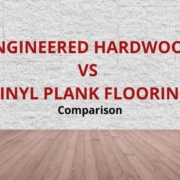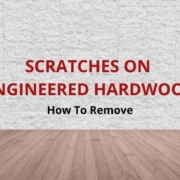How To Install Engineered Hardwood Over Concrete
If you own a home with a basement, chances are you’ve thought of putting it to better use. That ping-pong table stopped keeping the kids busy a long time ago and now, all it does is hold up a bunch of boxes. What’s stored inside them is anyone’s guess anymore.
If the space is truly a basement, there is probably some sort of opening besides the door at the top of the stairs. A transom style window or two. Possibly several of these. If your house is built into a hill, your basement might even have an exit door. Cellars don’t have this.
As long as there’s some form of egress and it stays dry even during the rainy season, then you’re in luck. Your basement could be an excellent candidate for use as a functional living space. Think home office or maybe a rental unit.
In this article, we’ll discuss what makes engineered hardwood a good choice for installation over concrete. We’ll also discuss the DIY installation of engineered hardwood and preventive measures to ensure its durability and longevity.
What is Engineered Hardwood?
Engineered hardwood planks are constructed in layers. The surface is made of the same wood as a regular wood plank. The surface layer is bonded to a core that’s made of several thin layers of plywood pieces that are crisscrossed and bonded together. There are as many types of engineered wood as there are species of trees. This makes for a wide selection of species and colors.
Is Concrete a Suitable Substrate for Engineered Wood Floors?
Honestly, it has nothing to do with any kind of fear of commitment; but there’s simply no way to answer “yes” or “no” to this question. So, the answer is; “It depends”.
It depends largely on the moisture content of the concrete that will be supporting your engineered hardwood floor. You’ll need a concrete moisture meter. Testing is something you can do on your own. Follow your flooring manufacturer’s recommendations to determine if your concrete floor requires a moisture barrier between it and your new floor.
Also, if you intend to glue your floor, it might help to know that some types of adhesives are also intended as moisture barriers. Because these two-in-one products are still new, they’re in short supply and retailers don’t seem to be able to keep many units of them in stock.
More importantly, you should know that lack of defense against moisture isn’t merely a cause of a failed installation. Lack of proactive protection in accordance with the flooring manufacturer’s recommendations is also a cause for a voided warranty.
Is Engineered Wood Suitable for Installation in a Basement?
The layered construction of its core makes engineered wood especially durable and less prone to expansion and shifting caused by environmental changes. It’s this type of construction that makes engineered hardwood so well suited to challenging environments like bathrooms & basements.
Choosing Between Installation Types For Engineered Wood Floor on Concrete
Most concrete floors require a barrier to protect the installed floor from the moisture they release. Trapped moisture can lead to mold, mildew, loss of adhesion.
Moisture can also cause a wood floor to warp and it can cause the layers of engineered wood to separate and lift or curl upward.
Nailed Engineered Wood Floor
To nail floorboards in place, the substrate must be made of wood. This means you’ll need to lay plywood, oriented strand board, or particleboard over the concrete. Again, to protect the wood from moisture contained in the concrete, an underlayment between the concrete and wood subfloor may be required.
Glued Engineered Wood Floor
Unless you intend to use a two-in-one adhesive, that is to say, an adhesive that’s also a moisture barrier, you’ll probably need to pass on this option. Gluing floorboards to the underlayment that sits on the concrete is not recommended.
Floated Engineered Hardwood Floor
Most engineered wood floors manufactured today are the tongue and groove kind. The boards interlock with one another so that neither glue nor nails are required to keep them in place. By virtue of this interlocking, the boards become a single, large sheet. This sheet sits on top of an underlayment to protect it from moisture that might come up from underneath it. Thus, the floor “floats”.
Between the interlocking capability and the way engineered wood is made, this is the type of installation most recommended for engineered wood over concrete in basements especially.
It’s also important to consider that a protective underlayment is also an excellent way to muffle sound. This can be a godsend when it comes to basements where sounds tend to echo, amplify, and bounce around.
Preparing To Install an Engineered Wood Floor on Concrete
Environmental Conditions
Concrete isn’t the only place where moisture can be a challenge. The intended environment of the engineered wood floor should always be paid equal attention. EMC (Environmental moisture content) should be evaluated using an EMC reader.
If the EMC is higher than recommended by your floor’s manufacturer, measures must be taken to reduce it and to keep it reduced. A dehumidifier is a good way to do this.
There is also the matter of ambient air temperature. It should be reasonably consistent and it should always measure between 60F and 80F.
Acclimation
It’s extremely important to put the boxes that contain your new floor inside the room where you plan to install them to allow the boards to acclimate to their intended environment. Some manufacturers suggest removing the boards from the packaging. None advise against it. Depending on the manufacturer’s instructions, the acclimation period is usually two to seven days.
Racking
Racking is a term defined as the laying out of the floorboards in advance of the actual installation. Doing this allows for staggered color variations and lengths whereas they might be grouped in one place if installed as they’re pulled from the box. Racking a floor also allows for any defective pieces to be withheld for return to the manufacturer.
Patching and Leveling
For your concrete slab to function as a subfloor, holes, cracks, and low spots need to be patched. The subfloor also needs to be level for your engineered wood floor to be level. A deviation of 3/16” over a 10’ span is the usual maximum allowable.
Before taking on the tasks of patching and leveling, the subfloor must be clean and free of loose debris. Nothing dramatic, but if there are any large, greasy, or oily stains, these could cause loss of adhesion. Use a degreasing, grill, or oven cleaning type of solution to eliminate them.
For holes and large chips in your concrete subfloor, use a self-leveling concrete patching compound. Very carefully follow the instructions on the back of the package. Allow the patching compound to cure completely.
Once the patching compound has cured, use a level to determine if the floor is level. If any area of the floor is off-level by more than ⅜” over a span of 10’, this will need to be corrected by the leveling process.
In some cases, the concrete might have several low areas. If you’ve ever wet mopped your concrete floor, these areas evidenced themselves by puddling or being the last to dry. There might even be a white ring around them. These areas are also part of the focus of the leveling process.
Use a primer and leveling compound to level your concrete floor. As the term suggests, the primer should be applied first as this will ensure adhesion of the leveling compound to the existing concrete.
Applied with a smooth trowel and a floor squeegee, the leveling compound will also serve to fill small cracks and spalls or chips.
Again, the importance of following the instructions on the back of the products’ packaging to the letter, can’t be overemphasized.
Underlayment/Moisture Barrier
If your moisture readings call for it, you’ll need to apply an underlayment with moisture or vapor protection over your now level concrete substrate. These underlayments are available in sheets or rolls, and in thicknesses from 2mm to 6mm.
Quite candidly, less than 3mm thick won’t affect the moisture blocking aspect, but it won’t have much effect on the noise aspect either.
Laying The Boards
You’ll Need:
- Tape measure
- Chalk line cartridge with string and chalk
- Carpenter’s pencil, grease, or china pencil
- Chop saw and blade
- Table saw and blade (for ripping floorboards along the length)
Determining Gap
The instructions that are packed with your engineered hardwood indicate the size of the gap between your floors and walls. In most cases, ½” is recommended.
For some reason, some contractors will tell you to leave a gap between two perpendicular or intersecting walls in a room only. This is incorrect.
It’s also very foolish.
If you think about it, wood doesn’t simply decide to expand ½” to the east and north sides of a room only. It expands in all directions. If the floor isn’t gapped on all sides, the side that isn’t gapped will push against the abutting wall and shift the floor toward the gapped side. This makes the floor liable to fold or buckle next to the east and north sides of obstacles such as posts, islands, and doorways. Gapping is why baseboards (skirting) were invented and yes, even if you have cinder block walls, they can be attached. So go ahead and gap your floors on all sides. You’ll be okay. Honest.
Cutting the Boards
Since you’ve already racked your floors in a way that the end seams are staggered, then you should already know which pieces need to be cut. You’ll also have a pretty good idea of how long the boards should be at each end.
However, because it isn’t terribly likely that the room isn’t perfectly square, cutting end pieces in advance should be avoided.
Assuming you’ve decided to float your engineered hardwood floor, it’s best to start fitting the pieces together according to your racking layout. Start from the center of the room and make each of your cuts when it’s time.
When you’ve determined the precise center point of the room, snap a chalk line in either direction. The lines should intersect forming 90-degree angles. You’ll be using these lines for reference to keep your floorboards aligned. If it appears the pieces that run along either wall will need to be cut to a more narrow width than the instructions allow, you’ll need to remove a board shift and nudge the rest to make things work. Remember, you’re also cutting to allow for a gap.
By the way, the shifting and nudging thing is part of a floating floor’s charm!
Finishing Your Engineered Wood Floor
Another part of a floating floor’s charm is that now that you’ve snapped in the last board, you don’t need to wait for glue or lacquer to cure and dry. While you were doing your research and shopping for your new floor, you probably discovered that most engineered wood floors are pre-finished. You can walk on your new floor right away. You can also move furniture right away.
This means you can set up that bar along with the ice bucket and libations. Pull up a stool and raise your glass to yourself for a job well done.
Aftercare, Maintenance, and Monitoring of Your Engineered Wood Floor
To keep your engineered wood floors look their best:
- Clean spills immediately
- Keep your new floor free of dust and debris as these can scratch your floor’s finish
- Use a good floor vacuum or your vacuum’s floor accessory tool.
- Damp mop only using an appropriate cleaning solution
- Exchange shoes for house slippers upon entering
- Place throw rugs in high traffic areas
- Keep furniture from slipping by using furniture cups
- Place felt pads under chair and barstool feet
- Lift storage boxes instead of dragging
- Keep pets’ nails trimmed
- Keep potted plants in stands or furniture
- Monitor the EMC and continue dehumidifying
As you can see, keeping your new engineered wood floors in good condition is more about what to avoid and what not to allow. Upkeep is relatively simple and takes very little time. No one would guess that a floor that looks so good could require so little effort.
Besides the way it looks, the best thing about your engineered wood floor is the money you saved installing it yourself. Enjoy!
Table of Contents





